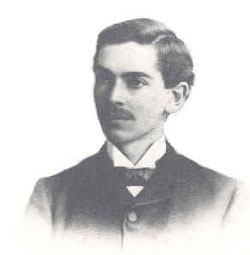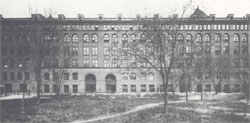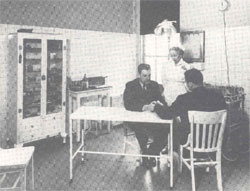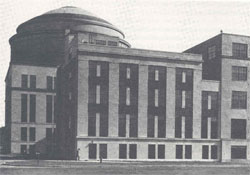
| Vol.
XXII No.
4 March / April / May 2010 |
| contents |
| Printable Version |
The MIT Medical Department 1901-2004:
A Very Brief History
The information presented in this brief account of the provision of medical care for the MIT community comes from a large file folder found in the files of the Medical Director’s office, from a charming 91 page volume entitled “The MIT Medical Department 1901–1976; A Personal History,” by Samuel D. Clark, MD, and from discussions with current and past members of the MIT Medical Department.
For the first 40 years of its existence, MIT apparently did not have any organized system for the provision of medical care. Students commuted from home or lived in near-by boarding houses and presumably had their health care needs met within the Boston community.
Although provision for the care of illness and injury for students has been a clear goal of the medical services provided by MIT, there has also been an important emphasis on two other important roles: workplace care for those employed by MIT and active management of injury or disease resulting from the work of engineering and science. Using the same staff and the same facilities, these three important roles have been played by the Department for most of its 100 plus years of existence.
In the large file folder, in Dr. Clark’s book and in discussions with colleagues, the history of the Medical Department is variously described based on the physical facilities dedicated to the endeavor, the people involved and the services provided. What follows is a very brief review of the important events in the century of care provided to the MIT community by the Medical Department.

1901
Franklin W. White, MD, an 1890 graduate of MIT, was appointed Medical Advisor to the Institute. He provided medical care at his private office on Marlborough Street – not far from the Institute’s Copley Square location. He also, apparently, provided lectures on health-related topics.

1910
A room in Pierce Hall (near the entrance to the current Copley Plaza Hotel) was made available for Dr. White to see students without payment of a fee. Eventually, students were required to have a physician examination during their first month at the Institute. Apparently, careful anthropometric measurements were made and posture abnormalities were identified and corrective exercises recommended.
1915
Dr. White retires and J. Arnold Rockwell, MD (Class of 1896 and source of the name for the “Rockwell Cage” at the athletic facility) replaces Dr. White. As the “cage” that bears his name implies, Dr. Rockwell was very interested in college athletics and was an ardent supporter of athletic activities.
1917
The Institute moves to its present location in Cambridge and two rooms are set aside in Building 3 for the provision of medical care and a “First Aid Room” is set up in the office of the Superintendent of Buildings.
A group of undergraduates, the “Ways and Means committee”, recommends that a small amount (about 57 cents per student when implemented) be added to the tuition as a fee, so that medical care could be made more available. This would, they argued, lower the threshold for seeking care and forestall serious problems. They stated, “that the expense of the medical service should be borne by the student body as a whole.”
1921
George W. Morse, MD replaces Dr. Rockwell and is given the title Medical Director. He was a graduate of Harvard College and Harvard Medical School and was a surgeon by training. Referred to by some as “the knife”, Dr. Morse was also named head of the Department of Hygiene. In this capacity, along with the support of Alan Rowe, PhD (not MD) who was Director of Research at Evans Memorial Hospital, a Boston University Medical School facility, he reportedly was also interested in health maintenance and preservation: “Pitfalls beset him [the student] at every turn and the greatest of these are the quick lunch counter and the unused bed.” In addition to lectures on hygiene, a physical examination for each student every 6 months was recommended!


1928
Named for Richard Holmberg ’23, who died as a Senior of pneumonia, the Holmberg Infirmary (now Building 11) opened providing an inpatient hospital facility in addition to expanded space for the care of students and employees.
1942
Dental Services began to be available at the MIT Medical Department. Initially dental hygiene was all that was available, but gradually a wider range of services became available.
1946
Dana L. Farnsworth, MD – an Internist and Psychiatrist – replaces Dr. Morse and is the first full-time Medical Director. Dr. Farnsworth came with eleven years of experience in college health at Williams College and several years of experience in the U. S. Army. He is reported to have said: “College health is mental health”.
In a 1953 article in the New England Journal of Medicine, Dr. Farnsworth outlined the objectives of a college health service:
- to promote individual and general health care;
- to prevent injury;
- to serve as an educational center and to collect data;
- to free students and staff from physical and emotional handicaps;
- to care for sick students and staff members
During his nearly nine-year tenure, Dr. Farnsworth clearly focused his efforts on the development of services to support his objectives. A full-time psychiatrist and a full-time otolaryngologist were hired. On site laboratory services were added in 1947 and a program termed “Faculty Health Survey” was started in 1952. In this program, faculty members with the rank of Assistant Professor or higher could have – at no charge – an annual physical examination. In addition, consultations with available specialty services, psychiatry and ENT, were available. The “Faculty Health Survey” paralleled the “executive physical” that was popular in the 1950’s and 60’s in the business world. The eligibility requirements were frequently adjusted so that other, non-faculty members, of the Institute could enjoy this service.
1948
The first full –time psychiatrist is appointed to the staff.
1949
Occupational Medical Service is established. Developments in science, engineering and warfare brought new and special risks to the scientists, engineers and technicians who worked in laboratories and facilities like MIT. MIT was one of the first institutions to establish a program to actively identify and manage these issues. Dr. Harriet Hardy headed the program and became a recognized pioneer in this important endeavor.
1954
Dr. Farnsworth leaves MIT to become Medical Director at Harvard University Health Services. He is replaced briefly by J. Howard Means, MD recently retired chief of Medicine at MGH and former president of the American College of Physicians. Dr. Means was a strong proponent of high quality care for the entire community and proposed two radical, inter-related concepts – the Medical Department as a teaching department and a pre-paid program of medical care. He proposed that the Medical Department become a two-year Medical School. He felt that, especially at MIT, combining education, research and practice should be done in medicine just as it is done so well in engineering. In addition, he proposed a pre-paid medical care plan for the MIT community. He argued that the teaching role of the Department and the provision of prepaid medical care would be the source of strength for each other.
Dr. Means also argued that on-site care for the MIT community not only made good medical sense, it also made good financial sense. In his view the value of time lost from the work of the Institute – at any level or job – was at great cost, a cost that could be minimized by the provision of on-site care.
1955
James Faulkner, MD becomes Medical Director. He served until 1960.
1957
Obstetrical care needs were clearly identified and, in cooperation with the Boston Lying-In Hospital (BLIH, now Brigham and Womens Hospital (BWH)), arrangements were made to have the chief resident (Dr. Ruby Jackson) provided pre- and post-natal care at MIT for one session per week. The service continued for several years at the BLIH facility and in 1963 a part-time gynecologist was hired by the Institute to provide on site OB and Gyn care. OB/GYN continued until 2004 to be provided at BLIH and its successor BWH.
1960
Albert O. Seeler, MD, an internist and toxicologist, becomes Medical Director. He had joined the Department in 1956 as an internist. Prior to coming to MIT, he was actively involved in patient care and teaching on the Harvard services at Boston City Hospital and at Mount Auburn hospital. His relationship with the Mount Auburn hospital led to the frequent use of this facility for cases that could not be managed in the MIT Infirmary.
His concern for the MIT community lead to continued growth of the Medical Department and most importantly to the establishment of the MIT Health Plan – a prepaid, HMO for the MIT community.
1960s
A number of changes are occurring in the financing of health care – Medicare, an insurance program for senior health care, goes into effect and health insurance becomes an important component of employee benefits in many industries. In an effort to control costs and improve care, pre-paid health care systems are developed and federal legislation is put in place to support the development of Health Maintenance Organizations (HMOs). Planning begins for what will become the MIT Health Plan.
To meet the increasing demands for dependent care, pediatricians and gynecologists are added to the staff.
1964
The MIT General Clinical Research Center (CRC) is established. The CRC is currently one of 80 centers across the country receiving major, continuing support from the National Center for Research Resources within the National Institutes of Health. It provides a facility where expertise in basic science and engineering can be applied to the study of human physiology and the treatment of human disease.
1970
After the Sancta Maria Hospital moves from its Memorial Drive location to Concord Avenue in Cambridge, the building is acquired by MIT. The Holmberg Infirmary moves from Building 11 to Building W5, the refurbished Sancta Maria Hospital building. Outpatient care remains in building eleven.
1970
The Harvard-MIT Division of Health Sciences and Technology (HST) is launched after several years of planning. The HST program represents the first lasting major academic collaboration between Harvard and MIT. It fosters collaborative efforts in medical education, biomedical research and health care. The MIT home of the HST program is housed in Building E25 and shares a common entrance atrium with the Medical Department Building E23. In addition, several Medical Department staff members are actively involved in the activities of the HST program.
1974
The MIT Health Plan starts. Initially a trial program, it was limited to 1000 members. It was a very popular and successful endeavor and soon grew to the 7000 to 9000 member range. The presence of this pre-paid plan allowed for growth of the Medical Department and a marked expansion of the services available on campus. Clearly, this benefited not only the members of the Health Plan but also the students of MIT.
1976
Charles J. Hatem, MD joins the staff of the MIT Medical Department and supervises the medical care of MIT patients at the Mount Auburn Hospital. His role was essentially that of what would be called a “hospitalist” today. This arrangement continued until his retirement in 1997.

1982
After several years of planning, the MIT Medical Department moves into its current home, Building E23
1997
The MIT Medical Department enters into an affiliation agreement with Partners Health Care (the umbrella organization that includes the Massachusetts General Hospital (MGH) and Brigham and Women’s Hospital (BWH). On the occasion of Dr. Hatem’s retirement the question of hospital affiliation was reassessed and a decision was made to hospitalize MIT patients for medical and surgical care at the Massachusetts General Hospital. Obstetric and Gynecologic hospital care continued at the Brigham and Women’s Hospital.

2003
A group of MIT students, graduate and undergraduate form an ambulance service. In addition to providing ambulance services the group has setup an active education program enabling a large number of students to become certified emergency medical technicians. With the help of the Medical Department, the Office of the Dean for Student Life and the Campus Police, the service provides high quality, student and campus friendly emergency medical transportation.
2004
Hospital level care provided by the Obstetrics and Gynecology Service moves to the Mount Auburn Hospital. High-risk obstetrical care and complex GYN surgery continue to be provided at the Brigham and Women’s Hospital. Midwifery and access to obstetrical care in the western suburbs are now available via the Medical Department’s care programs.
For over 100 years MIT has provided care to its community. Students, faculty, staff and their families can receive care at a facility that has a long tradition of caring for the medical and health needs of this special community. The people, the buildings, the affiliations and some of the services have surely changed over the past century, but the commitment to the health, safety and care of the MIT community has not changed.
| Back to top | |
| Send your comments |
| home this issue archives editorial board contact us faculty website |